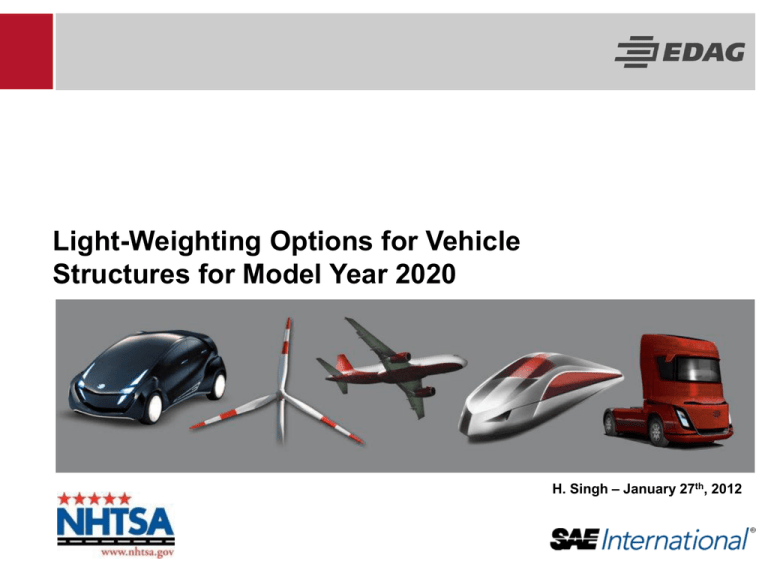
Light-Weighting Options for Vehicle
Structures for Model Year 2020
H. Singh – January 27th, 2012
1
NHTSA Light Weighting Project
2
High Volume Production Cycle Time
3
Materials and Manufacturing Processes for High Volume Production
4
Vehicle System Weights and Light Weighting Options
5
CAE Simulation Results comparison with test results
6 Conclusions
EDAG Inc. 1-4-10
Page 2
© Copyright 2009 EDAG. Alle Rechte vorbehalten. / All rights reserved.
Fo 11 07/030/06/5
How Much Mass Reduction is Feasible for a
Midsize Sedan for Model Years 2017-2025?
1.
Baseline vehicle 2011 Honda Accord
2.
Identify light weighting technologies for 2020 model year
vehicle
3.
Cost no higher than 10% of current baseline vehicle’s MSRP
4.
Same vehicle performance and functionality
5.
All recommended technologies to be suitable for 200,000
annual production, 1 Million vehicles over 5 years
6.
Deliver a detailed CAE model to NHTSA suitable for further
safety related work
EDAG Inc. 1-4-10
Page 3
© Copyright 2009 EDAG. Alle Rechte vorbehalten. / All rights reserved.
Fo 11 07/030/06/5
High Volume Production Cycle Time
200,000 Annual Production
•
4,000 Weekly (50 Weeks per Year)
•
800 Daily (5 Days per week)
•
50 Hourly (16 Hours – 2 shifts)
One a Minute!
EDAG Inc. 1-4-10
Page 4
© Copyright 2009 EDAG. Alle Rechte vorbehalten. / All rights reserved.
Fo 11 07/030/06/5
Mass Saving Cost Boundaries for This Study
1. Vehicle Mass 1480.5 kg (Mid Size Sedan – Honda Accord)
2. Vehicle MSRP - $22,730
3. Manufacturing Cost - $14,700 (using RPE 1.47)
4. 10% Cost Increase; equivalent to $1,546
150 kg mass saving at $10.00 Per kg Mass Saving Premium
Or 300 kg mass saving at $5.00 Per kg Mass Saving Premium
10% Vehicle Mass Reduction leads to
approx 6.5% increase in fuel economy
EDAG Inc. 1-4-10
Page 5
© Copyright 2009 EDAG. Alle Rechte vorbehalten. / All rights reserved.
Fo 11 07/030/06/5
Materials Cost Comparison
EDAG Inc. 1-4-10
Page 6
© Copyright 2009 EDAG. Alle Rechte vorbehalten. / All rights reserved.
Fo 11 07/030/06/5
Materials &
Manufacturing Technology
EDAG Inc. 1-4-10
Page 7
© Copyright 2009 EDAG. Alle Rechte vorbehalten. / All rights reserved.
Fo 11 07/030/06/5
Materials &
Manufacturing Technology
EDAG Inc. 1-4-10
Page 8
© Copyright 2009 EDAG. Alle Rechte vorbehalten. / All rights reserved.
Fo 11 07/030/06/5
Manufacturing Assembly Technology
EDAG Inc. 1-4-10
Page 9
© Copyright 2009 EDAG. Alle Rechte vorbehalten. / All rights reserved.
Fo 11 07/030/06/5
Vehicle Pay Load – Mid Size Sedan
(Honda Accord)
Occupants
Luggage
Towing (1000 lbs)
Mass (kg)
Payload
Non
Structural
Body
Structure
Chassis
Power
train
GVW
Honda Accord
- 2011
385
465.1
343.8
287.8
383.3
1865
21%
25%
18%
15%
21%
EDAG Inc. 1-4-10
Page 10
© Copyright 2009 EDAG. Alle Rechte vorbehalten. / All rights reserved.
Fo 11 07/030/06/5
Non Structural Weight
Seats
Airbags and restraints
Interior Trim
Instrument Panel
Entertainment
Heating & Air-conditioning
Closures
Mass (kg)
Payload
Non
Structural
Body
Structure
Chassis
Power
train
GVW
Honda Accord
- 2011
385
465.1
343.8
287.8
383.3
1865
21%
25%
18%
15%
21%
EDAG Inc. 1-4-10
Page 11
© Copyright 2009 EDAG. Alle Rechte vorbehalten. / All rights reserved.
Fo 11 07/030/06/5
Chassis Weight
Front and rear suspensions
Brakes System
Wheels & Tires
Mass (kg)
Payload
Non
Structural
Body
Structure
Chassis
Power
train
GVW
Honda Accord
- 2011
385
465.1
343.8
287.8
383.3
1865
21%
25%
18%
15%
21%
EDAG Inc. 1-4-10
Page 12
© Copyright 2009 EDAG. Alle Rechte vorbehalten. / All rights reserved.
Fo 11 07/030/06/5
Powertrain
Engine & Transmission
Drive-shafts
Exhaust System
Fuel System
Mass (kg)
Payload
Non
Structural
Body
Structure
Chassis
Power
train
GVW
Honda Accord
- 2011
385
465.1
343.8
287.8
383.3
1865
21%
25%
18%
15%
21%
EDAG Inc. 1-4-10
Page 13
© Copyright 2009 EDAG. Alle Rechte vorbehalten. / All rights reserved.
Fo 11 07/030/06/5
Body Structure Weight
Body Structure
Front & Rear Bumpers
Mass (kg)
Payload
Non
Structural
Body
Structure
Chassis
Power
train
GVW
Honda Accord
- 2011
385
465.1
343.8
287.8
383.3
1865
21%
25%
18%
15%
21%
EDAG Inc. 1-4-10
Page 14
© Copyright 2009 EDAG. Alle Rechte vorbehalten. / All rights reserved.
Fo 11 07/030/06/5
LWV Design Options
Body Structure and Closures
EDAG Inc. 1-4-10
Page 15
© Copyright 2009 EDAG. Alle Rechte vorbehalten. / All rights reserved.
Fo 11 07/030/06/5
Body Structure Options
EDAG Inc. 1-4-10
Page 16
© Copyright 2009 EDAG. Alle Rechte vorbehalten. / All rights reserved.
Fo 11 07/030/06/5
Front Doors
Option 2 – Magnesium HPD Casting
Combine several parts
Will require high tonnage press
EDAG Inc. 1-4-10
Page 17
© Copyright 2009 EDAG. Alle Rechte vorbehalten. / All rights reserved.
Fo 11 07/030/06/5
Light Weight Vehicle - Body and Closures
Optimized
Advanced High Strength
Steel Body Structure
(-82 kg)
Aluminum
deck lid assembly
(-4.9 kg)
Aluminum
Hood Assembly
(-7.5 kg)
Hot Stamped Bumper
(-3.5 kg)
Aluminum front
door assemblies
(-15.2 kg)
Hot Stamped Bumper
(-3.6 kg)
Aluminum fenders
(-3.6 kg)
Aluminum rear
door assemblies
(-11.5 kg)
Honda Accord
(kg)
LWV
(kg)
438.5
308.4
EDAG Inc. 1-4-10
Page 18
© Copyright 2009 EDAG. Alle Rechte vorbehalten. / All rights reserved.
Fo 11 07/030/06/5
Light Weight Vehicle - Body and Closures – Material
Selection
EDAG Inc. 1-4-10
Page 19
© Copyright 2009 EDAG. Alle Rechte vorbehalten. / All rights reserved.
Fo 11 07/030/06/5
Light Weight Vehicle Chassis
Macpherson
various materials
(-15.3 kg)
Various material
assembly
(-2.1 kg)
Brake system
(-18.2 kg)
Steering system
(-4.8 kg)
Aluminum
K frame assembly
(-11.2 kg)
Wheels & tires
(-14.2 kg)
Aluminum
cradle assembly
(-20.7 kg)
Honda Accord
(kg)
LWV
(kg)
287.8
206.1
EDAG Inc. 1-4-10
Page 20
© Copyright 2009 EDAG. Alle Rechte vorbehalten. / All rights reserved.
Fo 11 07/030/06/5
Light Weight Vehicle – Powertrain resized for same performance
Down Sized from
2.4L to 1.8L
(-28.6 kg)
5 speed
automatic
(-27.9 kg)
Fuel tank
(-1.8 kg)
Exhaust
(-1.7 kg)
Drive shafts
(-3.5 kg)
Honda Accord
(kg)
LWV
(kg)
383.3
311.7
EDAG Inc. 1-4-10
Page 21
© Copyright 2009 EDAG. Alle Rechte vorbehalten. / All rights reserved.
Fo 11 07/030/06/5
Light Weight Vehicle - Interior
Instrument Panel
(-4.2 kg)
Magnesium
/ Composite
Back Panel
(-6.2 kg)
Magnesium IP
Beam
(-5.3 kg)
Magnesium
intensive Frame
(-7.5 kg per seat)
Honda Accord
(kg)
LWV
(kg)
370.4
317.6
EDAG Inc. 1-4-10
Page 22
© Copyright 2009 EDAG. Alle Rechte vorbehalten. / All rights reserved.
Fo 11 07/030/06/5
Computer Optimization of LWV
EDAG Inc. 1-4-10
Page 23
© Copyright 2009 EDAG. Alle Rechte vorbehalten. / All rights reserved.
Fo 11 07/030/06/5
Vehicle Light Weighting
Topology Optimization
Topology Optimization –
predicted load paths
LWV Structure
EDAG Inc. 1-4-10
Page 24
© Copyright 2009 EDAG. Alle Rechte vorbehalten. / All rights reserved.
Fo 11 07/030/06/5
Vehicle Light Weighting
3G Optimization (Gauge, Grade & Geometry)
EDAG Inc. 1-4-10
Page 25
© Copyright 2009 EDAG. Alle Rechte vorbehalten. / All rights reserved.
Fo 11 07/030/06/5
Vehicle Light Weighting
3G Optimized – Section Comparison
LWV
Baseline
Honda
Accord
Rocker Section Comparison –
Body structure
EDAG Inc. 1-4-10
Page 26
© Copyright 2009 EDAG. Alle Rechte vorbehalten. / All rights reserved.
Fo 11 07/030/06/5
CAE Analysis Results for Light Weight Vehicle
CAE Analysis on LWV is performed and correlated with Honda
Accord 2011 for following Stiffness & crash tests:
Torsional and Bending Stiffness
Normal Mode Frequencies
USNCAP Frontal Rigid Barrier 35 mph test
IIHS offset barrier 40 mph deformable barrier test
USSINCAP Lateral side impact test
IIHS Side Impact 50 km/h test
NCAP Rigid Side Pole 20 mph test
IIHS Roof crush test
Rear 301 fuel tank integrity 50 mph test
EDAG Inc. 1-4-10
Page 27
© Copyright 2009 EDAG. Alle Rechte vorbehalten. / All rights reserved.
Fo 11 07/030/06/5
Light Weight Vehicle FEA Model
Number of Parts
702
Number of Beams
4,763
Number of Solids
272,214
Number of Shells
1,210,307
Number of Nodes
1,403,378
Total Number of Elements
1,487,424
EDAG Inc. 1-4-10
Page 28
© Copyright 2009 EDAG. Alle Rechte vorbehalten. / All rights reserved.
Fo 11 07/030/06/5
NVH and Stiffness Comparison
Description
Honda Accord
Test - stiffness
LWV Target
stiffness
LVW stiffness
Bending
stiffness (N/mm)
8,690
9,000
12,636
Description
Honda Accord
Test - stiffness
LWV Target
stiffness
LVW stiffness
12.33
12.5
16.25
Torsion stiffness
(KN-m/deg)
Frequency type
Front end
lateral mode
Second order
bending mode
First order
bending mode
Torsion mode
Target
Frequency (Hz)
LWV Frequency
(Hz)
35.10
41.78
39.30
41.12
44.20
47.18
50.10
48.97
EDAG Inc. 1-4-10
Page 29
© Copyright 2009 EDAG. Alle Rechte vorbehalten. / All rights reserved.
Fo 11 07/030/06/5
USNCAP Frontal Rigid Barrier 35 mph Test
Results of EDAG LWV crash model for this crash test has been correlated with Honda Accord
2011 test # 7078 done by MGA research corporation.
Curb weight of the LWV crash model = 1150 kg
Weight of 50th percentile male dummy on driver seat = 80 kg
Weight of 5th percentile female dummy on front passenger seat = 50 kg
Weight of instrumentation in the rear cargo area= 45 kg
Total test weight of the LWV Crash Model = (1150+80+50+45)= 1325 kg
Total test weight of Honda Accord 2011 crash test ( Test # 7078) = 1669 kg
EDAG Inc. 1-4-10
Page 30
© Copyright 2009 EDAG. Alle Rechte vorbehalten. / All rights reserved.
Fo 11 07/030/06/5
USNCAP Frontal Rigid Barrier 35 mph Test
LWV - CAE
Simulation
Honda Accord 2011
Test # 7078
EDAG Inc. 1-4-10
Page 32
© Copyright 2009 EDAG. Alle Rechte vorbehalten. / All rights reserved.
Fo 11 07/030/06/5
USNCAP Frontal Rigid Barrier 35 mph Test
Honda Accord 2011
Test # 7078
EDAG Inc. 1-4-10
Page 33
© Copyright 2009 EDAG. Alle Rechte vorbehalten. / All rights reserved.
Fo 11 07/030/06/5
USNCAP Frontal Rigid Barrier 35 mph Test
Crash pulse comparison of the Honda Accord 2011(Actual Test) and EDAG LWV
Occupant compartment intrusion comparison
EDAG Inc. 1-4-10
Page 34
© Copyright 2009 EDAG. Alle Rechte vorbehalten. / All rights reserved.
Fo 11 07/030/06/5
LWV – Mass Saving Summary
Mass (kg)
Payload
Non
Structural
Body
Structure
Chassis
Power
train
GVW
CVW
MSRP
Honda Accord 2011
385
465.1
343.8
287.8
383.3
1865
1480
$22,730
LWV
385
366.5
261.1
206.1
311.7
1530
1145
-21.2%
-24.1%
-28.4%
-18.7%
-17.9%
-22.6%
Mass
Reduction
EDAG Inc. 1-4-10
Page 35
© Copyright 2009 EDAG. Alle Rechte vorbehalten. / All rights reserved.
Fo 11 07/030/06/5
Conclusions
1. This study helps to demonstrate that mass reduction of up to 23% is
likely feasible, that maintains performance and safety functionality and
MSRP at +10% of the original baseline midsize sedan.
2. The approach for this study is an evolutionary implementation of
advanced materials and manufacturing technologies currently used in
the automotive industry.
3. The recommended materials (Advanced High Strength Steels, Aluminum,
Magnesium and Plastics) manufacturing processes (Stamping, Hot
Stamping, Die Casting, Extrusions, Roll Forming, Hydroforming) and
assembly methods (Spot welding, Laser welding and Adhesive Bonding)
are at present already used, some to a lesser degree than others.
4. The recommended technologies should be able to be fully developed
within the normal ‘product design cycles’ using the current ‘design and
development’ methods prevalent in the automotive industry.
EDAG Inc. 1-4-10
Page 36
© Copyright 2009 EDAG. Alle Rechte vorbehalten. / All rights reserved.
Fo 11 07/030/06/5
Partner Companies
Chartered in 1992, the NCAC at The George
Washington University's Virginia Campus is one of
the nation's leading authorities in automotive and
highway safety research.
Since its inception, Electricore has had a successful
history of collaboration with the departments of
Defence, Energy and Transportation in the
development, demonstration and deployment of
advanced technologies.
EDAG Inc. 1-4-10
Page 37
© Copyright 2009 EDAG. Alle Rechte vorbehalten. / All rights reserved.
Fo 11 07/030/06/5
Thank you for your
Attention
EDAG Inc. 1-4-10
Page 38
© Copyright 2009 EDAG. Alle Rechte vorbehalten. / All rights reserved.
Fo 11 07/030/06/5







